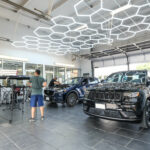Paintless Dent Repair (PDR). In this comprehensive guide, we’ll delve into the world of PDR, exploring its principles, benefits, limitations, and the types of damage it’s most suited to repair.
Understanding Paintless Dent Repair (PDR): Paintless Dent Repair, often referred to as PDR, is a revolutionary technique designed to restore the original form of a surface, be it a car panel or other metal surface, without the need for repainting. Unlike traditional methods that involve extensive sanding, filling, and repainting, PDR employs specialized tools and techniques to gently massage the dent from behind the panel, reinstating its original contour.
The Advantages of Opting for PDR:
- Cost-Effectiveness: One of the most appealing aspects of PDR is its affordability. By eliminating the need for paint and other materials, the cost of repairs can be significantly reduced.
- Time Efficiency: PDR is often a quicker process compared to conventional methods, allowing you to regain possession of your vehicle or property promptly.
- Preservation of Original Finish: PDR is a non-invasive technique, ensuring that your vehicle or property retains its factory finish. This is vital for maintaining resale value.
- Eco-Friendly: Traditional repair methods involve chemicals and materials that are harmful to the environment. PDR contributes to a greener approach to repairs.
- Value Retention: Keeping the original paint finish intact helps preserve the overall value of your asset.
The Types of Damage Perfect for PDR:
- Hail Damage: PDR is exceptionally effective for addressing the shallow dents caused by hailstones. It’s the preferred method for repairing hail damage due to its precision.
- Minor Dings: Those small yet bothersome dings inflicted by car doors or runaway shopping carts can be easily remedied through PDR.
- Minor Creases: As long as there’s no accompanying paint damage, PDR can smooth out minor creases.
- Small Dents: Whether from low-impact collisions or other minor accidents, small dents are typically prime candidates for PDR.
Recognizing the Limitations of PDR:
- Paint Issues: If the dent has caused paint to crack or chip, PDR might not be the most suitable solution. However, an experienced technician can assess and advise accordingly.
- Sharp Dents: Dents with sharply bent or stretched metal might not respond well to PDR techniques.
- Large Dents: While PDR can handle a variety of dent sizes, particularly large dents may necessitate traditional repair methods.
- Complex Dents: Dents with multiple angles or complex shapes may require a combination of PDR and other techniques for optimal results.
Choosing the Right PDR Professional: Making an informed choice about your PDR provider is paramount. Consider the following factors:
- Certifications: Verify that the technician is certified and has received proper training in PDR techniques.
- Reviews: Look for positive feedback and reviews from previous clients to gauge the quality of their work.
- Experience: An experienced technician is more likely to deliver exceptional results due to accumulated skills and expertise.
- Warranty: A reputable provider should offer a warranty on their work, demonstrating their confidence in their services.
Conclusion: Paintless Dent Repair offers an innovative and efficient solution for various types of dents and damage caused by hail, accidents, and everyday mishaps. With its cost-effectiveness, time efficiency, and preservation of the original finish, PDR has become a popular choice for discerning vehicle and property owners. As you consider PDR for your repair needs, consulting a reputable professional is crucial in assessing the damage and determining whether this technique is suitable for your specific situation. Bid farewell to unsightly dents and welcome back the pristine appearance of your cherished possessions.
For expert hail damage repair through Paintless Dent Repair, contact Dillon Hail Repair today at (972) 559-0555. Our skilled technicians are dedicated to restoring your vehicle’s or property’s appeal without compromising its original finish.








